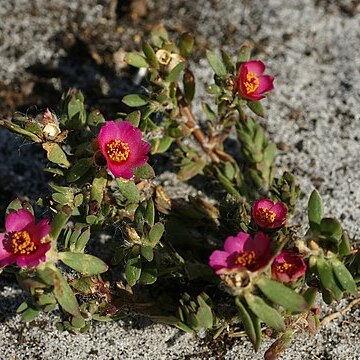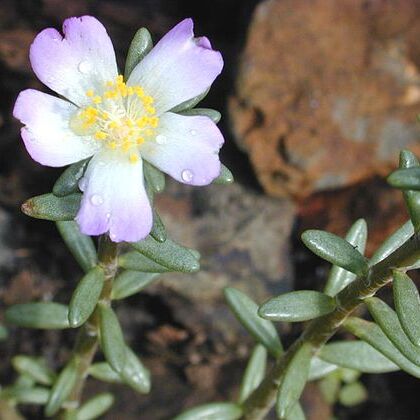Herbs, annual (perennial in P. suffrutescens). Roots tuberous, fleshy, fibrous, or small taproots. Stems erect to prostrate, branched, fleshy or suffrutescent; trichomes in inflorescence or stem nodes absent or present, glabrous otherwise. Leaves alternate or subopposite, congested and involucrelike immediately proximal to inflorescence; blade terete, subterete, or flattened. Inflorescences terminal in clusters, or axillary on short branches. Flowers sessile or subsessile, usually open only in sunshine; sepals broadly clasping at base, herbaceous to scarious, falling from top of capsule; petals ephemeral, 5-7, usually distinct, margins usually entire; stamens (4-)6-40(-100); ovary half inferior to inferior, plurilocular proximally to 1-locular distally, placentation free-central; style 1, short, stigmas 3-8(-18). Capsules membranaceous, chartaceous, dehiscence circumscissile. Seeds many, brown to black or gray, reniform to cochleate; seed coat smooth or variously sculptured, granular to stellate-tuberculate or spiny. x = 4, 5, 8, 9.
Annual or perennial, prostrate to ascending, succulent herbs. Leaves alternate or subopposite, often upper ones crowded in a foliar involucre around flowers, flat or terete, sometimes succulent; stipules scarious, fimbriate or present as tufts of hairs, rarely absent. Inflorescences of subapical flowers, clustered in a capituliform cyme or solitary. Sepals 2, opposite, free or connate below, unequal, usually persistent; petals (4-)5(-6), free or connate at base, falling off rapidly; stamens 4-8 or more, basipetalous, filaments often pubescent below; ovary inferior of half-inferior, ovules numerous, styles 2-9, united below, rarely free. Fruit a 1-locular, membranous or chartaceous, circumscissile capsule; seeds numerous, reniform or cochleate, testa smooth or tuberculate.
Annual or perennial herbs, succulent. Leaves alternate or approximate, terete to plane, often whorled about the flowers; stipules scarious, fimbriate or tufted, sometimes very small, rarely absent. Inflorescence near the stem apex, crowded, the flowers sometimes solitary, yellow to red. Sepals 2, opposite, connate below, the anterior larger than the posterior, usually persistent. Petals 4-6, connate at the base or free, somewhat auto-deliquescent. Stamens 4 to many, inserted at the base of the petals, the filaments often hairy below. Ovary half to wholly inferior, the ovules numerous, the styles 3-to 9-parted, rarely simple. Capsule circumscissile, chartaceous; seeds reniform to cochleate, numerous, the testa smooth or minutely tuberculate.
Mostly succulent, copiously branched herbs. Leaves linear to orbicular, in most species with axillary hairs. Flowers in (1-)2-30-flowered, terminal capituli; receptacle infundibular, mostly with hairs or scales in the axils of the bracts (and bracteoles), surrounded by a whorl of c. 3-30 involucral leaves (or in some Australian spp. in axillary and/or terminal dichasia). Sepals occasionally keeled or hooded, persistent or caducous with the petals, stamens and style. Petals 4-6(-8), mostly obovate, occasionally emarginate or mucronate. Stamens 4-∞, in 1 whorl. Ovary half-inferior, occasionally apparently inferior; style with 2-18 arms. Capsule with a caducous circumscissile operculum. Seeds ∞ (in some Australian spp. 1-4).
Herbs annual or perennial. Stems prostrate or decumbent; nodes or leaf axils with scales, bristles, and/or hairs, sometimes short and inconspicuous. Leaves alternate or opposite, usually sessile, flat or terete. Inflorescence a terminal head of sessile, solitary or clustered flowers, subtended by an involucre of leaves. Sepals connate at base into tube, persistent but inconspicuous. Petals 4 or 5(-8+), free or shortly connate at base. Stamens 4-100, adnate to base of petals. Ovary half-inferior. Stigma 2-9-lobed. Capsule circumscissile, sessile, globose or nearly so. Seeds mostly glossy black or iridescent gray, less often brown, orbicular-reniform, minute, often tuberculate, without caruncle.
Glabrous, taprooted, annual or perennial, fleshy herbs. Stems branching, prostrate to ascending, vegetative and reproductive. Lvs many, usually spiralled to subopposite, sometimes opposite, the uppermost whorled below the infl.; axillary hair-tufts present. Infl. terminal, few-flowered, bracteate, or fls solitary. Sepals hooded, the anterior overlapping the posterior. Petals 4-6. Stamens 4-many. Ovary semi-inferior, of 3-8 fused carpels; style branches 3-8. Capsule thin-walled, 1-locular, circumscissile; seeds many.
Sep 2; pet 4–6, commonly 5 (more in double-fld forms); stamens 6– many; ovary partly inferior; styles or style-branches (2)3–several; capsule circumscissile near the middle; seeds many; ours succulent annuals with mostly alternate cauline lvs, the uppermost crowded and forming an involucre to the fls, these sessile or nearly so, solitary or glomerate at the ends of the stem and branches. 100+. mostly warm reg.
Leaves shortly petiolate or sessile, opposite or alternate, fleshy, cylindric or plane, glabrous (at least in our species); stipules divided into numerous hairs or more rarely membranous or absent.
Ovary semi-inferior, 1-locular, at least in the upper part; placentation free central; ovules many or very rarely 1 or several; style simple with 2-several stigmas.
Sepals 2, unequal, the larger slightly enfolding the margins of the smaller, connate into a tube below, which is adnate to the base of the capsule.
Flowers sessile, solitary or a few together at the ends of the branches and surrounded by a group of 2-several apical leaves.
Petals 4–5 (6), fugacious, free or ± united, marcescent and enfolding the ripe capsule.
Seeds 1-?, usually reniform, smooth or variously tuberculate or granulate.
Annual, biennial or perennial herbs; branches erect or often prostrate.
Stamens 4 — c. 100, inserted on the corolla or at its base.
Capsule dehiscing transversely.


